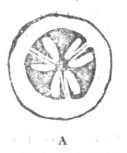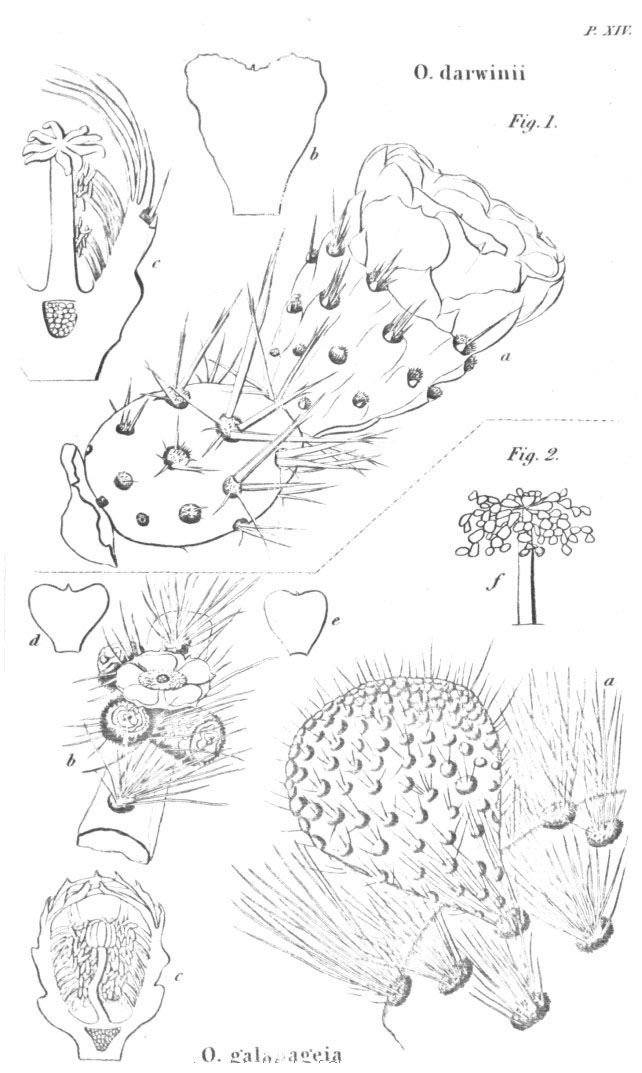[page] 466
X.—Description of two new speciez of Opuntia; with remarks on the Structure of the Fruit of Rhipsatis. By Rev. J. S. HENSLOW, M. A. Professor of Botany in the University of Cambridge.
Sp. 1. Opuntia Darwinii,—prostrate, articulis globoso-ovatis, aculearum validioribus elongatis trìeu, piliatis, floribus magnis solitariis.
Plate XLV. Fig 1.
THE terminal articulation (the only one seen) globoso-ovate, with distant areolæ beset with short tomentum, and those towards the anterior extremity with four to six stiff spines of various lengths, of which the stoutest are one and a half inches long, evidently formed out of three combined, and whose points are free, so that the compound spine appears compressed and tricuspidate. They mostly point forward, but some spread in all directions. Flowers solitary, larger than the articulations which they terminate, yellow. Perianth of six whorls, each of five parts, gradually passing from the form of small fleshy bracteal scales to membranous petaloid segments; spirally arranged at somewhat more than the fifth of a circle as under, so as to form five distinct secondary spirals, corresponding to as many, formed by the areolæ on the fleshy tube investing and surmounting the ovarium. These areolæ are placed upon slight tubercular elevations, each bearing a small fleshy bracteal scale, in whose axil is a tuft of yellow tomentum, and those on the upper extremity are also furnished with about half a dozen stiff acicular spines. The segments of the perianth pass gradually from the ovate-apiculate bracteal form of those in the outermost whorl to the cuneato-obcordate, and slightly mucronate petaloid form of those in the innermost, (Fig. b.)
Stamens numerous, covering the inner paries of the fleshy tube, (Fig. c.) Style remarkably stout, cylindrical, with nine thick radiating stigmata, reaching above the fleshy tube, and a little beyond the uppermost stamens. Ovarium, a small cell, the width of the style, surrounded by the very thick fleshy walls of the lower part of tube or floral receptacle. The character of the herbage appears to agree with that of Cactus moniliformis, Lin., which De Candolle places in his division Opuntiaceæ of the genus Cereus; and of which division he says, "An genus proprium inter Cereos et Opuntias medium?" The flowers of our plant, however, are strictly those of an Opuntia. In assigning the character of "tubum suprà ovarium nullum" to Opuntia, De Candolle must consider the whole of the fleshy tubular portion of the receptacle to which the stamens are at-
[page] 467
tached as part of the ovarium which, inceed, it appears to be, when seen from the outside of the flower, but in a transverse section (Fig. c.) is evidently prolonged above it.
I have named this interesting Cactus after my friend C. Darwin, Esq. who has recently returned to England, after a five years absence, on board his H. M. S. Beagle, whilst she was employed in surveying the southernmost points of South America. The specimen figured was gathered in the month of January, at Port Desire, lat. 47°. S. in Patagonia. He recollects also to have seen the same plant in flower as far south as Port St Julian in lat. 49°. S. It is a small species growing close to the ground on arid gravelly plains, at no great distance from the sea. The flowers had one day arrested his attention by the great irritability which their stamens manifested upon his inserting a piece of straw into the tube, when they immediately collapsed round the pistil, and the segments of the perianth soon after closed also. He had intended to procure fresh specimens on the following day, and returned to the ship with the one now figured, but unfortunately she sailed immediately afterwards, and he was prevented from obtaining any more. The geographical position of this species is beyond the limits hitherto assigned to any of the order, which are not recorded as growing much south of the tropic of Capricorn. The climate is remarkably dry and clear, hot in summer, but with sharp frosts during the winter nights. He found Cacti both abundant and of a large size, a little further to the north at Rio-Negro in latitude 41°. S.
Sp. 2. Opuntia galapageia.—articulis compressis (saltem junioribus) obovato-rotundis, aculeis setiformibus, longis, penicillatim dispositis, lanugine suprà ovarium densâ.
Plate XIV. Fig. 2.
I am also indebted to Mr Darwin for this second Cactus, of which he brought home in a dry state the specimens here figured. He found it at the Galapagos islands, where it attains to the form of a tree, averaging from six to ten feet high, and about a foot in diameter, perfectly cylindrical or very slightly tapering. The bark is pale-coloured, and in old trees hangs in a ragged manner upon the trunk, which is covered with very strong sharp spines, five to ten of which are set in each fasciculus, in a radiatory manner. From the summit of the trunk numerous branches spread on all sides, somewhat in the manner represented by Fig. f., taken from a very rude sketch of Mr Darwin's. He states these branches to be composed of compressed, rounded, oval articulations, each of which is about one foot in length, wholly without the true spines found on the trunk; but
[page] 468
With numerous scattered fascienli of long elastic bristles strongly resembling hogs' bristles.
Flowers solitary small, like shose of O. Hernandezii, a few together on the edges of the articulations, (Fig. b) red, with the lanugo in the areola on the ovarium, dense, especially towards the upper parts, and with a dense tuft also surrounding its base. Outermost segments of the perianth somewhat scarious, cuneato-obcordate, with an apex, the innermost membranaceous petaloid obvate, emarginate, with a slight mucro. Stamens very numerous and crowded, covering the whole inner surface of the tube. Style cylindrical, stout, (flexuous?) with eight stigmata, which are thick, erect, and closely appressed.
This species grows in the lower regions of James's Island, one of the Galapagos, where the soil is extremely arid and rocky, and where it is the only plant of sufficient magnitude to afford any shade, the next in size forming nearly leafless bushes. The want of water is very great, and the succulent branches of these trees are eagerly devoured by the large tortoises from which the islands have received their name, by large lizards which also abound, and by various other animals. Mr Darwin considers that they are occasionally furnished with a supply of this food from branches broken off by the wind. He found that lizards four feet in length were easily enticed, whenever he threw them a piece of a branch, and small birds would come within a few feet of him and peck at the one extremity, whilst the lizard was eating at the opposite end.
Another Cactus was observed in these islands with the habit of Cereus peruvianus, but which does not attain to more than two or three feet in height. It is the first plant that takes possession of the newly formed beds of lava. Not finding it in flower, Mr Darwin did not preserve a specimen.
Explanation of the Figures.
Fig. I. (a) an articulation with a flower; (b) a petal: (c) a longitudinal section of the flower, shewing the position of the stamens, &c. All of the natural size.
Fig. II. (a) part of a large articulation, with a young one attached to it ; (b) four flowers, one expanded, and three in bud, seated on the edge of an articulation; (c) a longitudinal section of a flower bud enlarged ; (d) a sepal or outer segment of the perianth; (e) a petal or inner segment; (f) a rough sketch of a tree. All, except c and f, of the natural size.
[page] 469
On the Structure of the Fruit of Rhipsalis.
The fruit of Rhipsalis has been considered to possess a different structure from that of all other Cacteæ, in having placentæ in the axis of the berry instead of on the paries, and the berry itself has also been considered as probably trilocular, whilst those of all other genera in the order are unilocular. Hence De Candolle has placed it in a separate tribe, his lehipsalideæ, expressing, however, some doubts about the accuracy of the observations upon which he has founded his arrangement. In his last memoir on the Cacteæ (1834,) he separates Rhipsalis salicornioides from the rest, under the generic name of Hariota; and in that species he states that he had ascertained the ovary to be unilocular, and the placentæ parietal. I have lately had an opportunity of examining the fruit of Rhipsalis cassytha in all stages of its growth, and can safely assert that both suppositions, of its being trilocular and having central, placentæ, have originated in a mistake. When the fruit is ripe, the seeds are nestled in the midst of a very liquid pulp, and are no longer attached to any part; but in earlier stages of its growth, they are found to adhere in double rows upon three placentæ, disposed longitudinally on the paries. At first sight there is a deceptive appearance of three dissepiments, or at least of three inwardly projecting placentæ to the innermost extremities of which the seeds are attached; but further examination shews this to arise, merely from the close agglomeration of the funicular chords (see Fig. A,) which stretch from the paries towards the axis, and from whose extremities the ovules are suspended in a reversed position. The placentæ themselves scarcely form any projection on the paries, as is very evident in some cases where many of the ovules have become abortive; and, indeed, several are so in all cases, and then appear as small brown spots attached to the paries. It seems to me likely that the watery pulp in which the seeds are nestled in this and other genera of the order is derived from the super-developement of the cellular tissue of the funicular chords. The whole coat of the berry, formed by the union of the calyx tube and pericarp, is very succulent, but the interior pulp is much more so; and this does not appear any way connected with, or to originate from the inner coats of the pericarp, but in the way here suggested. Be this as it may, it is sufficiently evident that the ovary and fruit of Rhipsalis are strictly unilocular with parietal placentæ, as in all other Cacteæ, and, consequently, it is necessary that the tribe Rhipsalideæ should be suppressed.

[Plate XIV]
